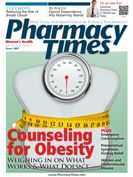Publication
Article
Pharmacy Times
Breakdowns During the Dispensing Process
Author(s):
Miscommunication or misinterpretation can lead to medication errors at several points in the dispensing process.
Miscommunication or misinterpretation can lead to medication errors at several points in the dispensing process.
Medication errors can occur during all phases of the medication-use process, including prescribing, dispensing, administration, or monitoring. This month we focus on 3 that occurred during the dispensing phase.
Pharmacy Voicemail
Staff at a physician’s office left a telephone order on the pharmacy’s voicemail system. The physician intended the patient to receive the antidepressant fluoxetine 10 mg but the pharmacist interpreted the voice mail message as Loxitane (loxapine) 10 mg, used to treat psychosis. Both medications are available as 10 mg capsules. The error continued for months until it was discovered by the physician. It was reported that the patient did not suffer any adverse effects.
To prevent errors such as this, the prescriber should spell out the drug name and sound out the dose (eg, 1-5 instead of 15), provide the indication, and use both brand and generic names when prescribing these drugs. Pharmacies should record information on their outgoing voicemail messages to prompt prescribers to provide this information. Also, as a redundancy, a second person in the pharmacy should listen to the order—this should be a requirement if the recipient is inexperienced.
Dispensing Refills
While verifying a refill for pravastatin using the scanned image of the original prescription, a pharmacist discovered that the prescription had incorrectly been filled with 20-mg tablets instead of 40 mg on 2 previous occasions. The data entry error had not been caught initially, nor when the first refill was dispensed. It happened despite the fact that the scanned image of the original prescription was displayed for verification.
Confirmation bias may play a significant role when prescriptions are being refilled. We tend to think that our coworkers—or even we ourselves—correctly verified the original dispensing of the medication. This causes us to drift into atrisk behaviors, such as not checking the original prescription for errors in directions, drug, or strength with each refill.
The Institute for Safe Medication Practices receives many reports of errors that were discovered upon refilling prescriptions after several wrong refills due to not verifying the original prescription each time. Many pharmacy systems have the capability of viewing the original prescription through a scanned image every time the prescription is refilled. Work flow procedures for checking original prescriptions via the scanned image at verification with every dispensing should be part of the process and continually emphasized with the entire pharmacy team.
Checking Vial Contents
A patient was to receive 2 prescription medications, Diovan HCT (valsartan and hydrochlorothiazide) 320 mg/12.5 mg and simvastatin 40 mg. However, the patient received 2 prescription vials containing Diovan HCT, one labeled Diovan HCT and the other labeled simvastatin, because the pharmacy technician inadvertently placed Diovan HCT into both vials. The patient discovered the error and brought the medications back to the pharmacy.
During the production phase of the dispensing process, it is important for pharmacy staff to work on only one prescription at a time, even if bar-code scanning technology is used. During final verification, pharmacists should open the prescription vials, visually inspect the medication, and compare the tablets to an image on the computer screen, the contents of the manufacturer bottle, or the tablet description printed on the pharmacy label.
At the point of sale, open the bag with the patient. Have the patient look at the prescription vials and the medications they contain to verify what was ordered and expected. If a friend is picking up the prescription, the patient should be told to open the package at home and check the contents before taking any of the medication.
Dr. Gaunt is a medication safety analyst and the editor of ISMP Medication Safety Alert! Community/Ambulatory Care Edition







